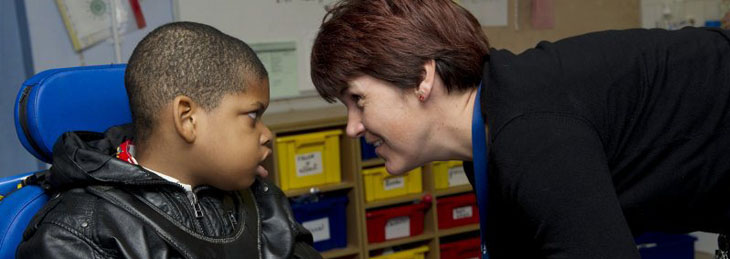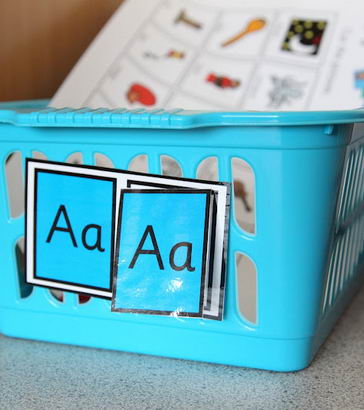
The ability to communicate is an essential life skill for all children and young people and it underpins
a child's social, emotional and educational development.
DCSF, 2008
There have been marked eras where psychological theory and research have impacted on practice.
Click on each row to find out more:
| DATE | MODELS | PARADIGM | INTERVENTION |
| 1970s | MEDICAL | Therapy |
helping and healing |
| 1980s | SOCIAL | Behaviourism |
'precision teaching' |
| 1990s | NORMALISING | Interactionism |
'active learning in social contexts' |
| 2000s | RADICAL | Personalisation |
'eclectic', 'holistic', 'the child's voice' |
Following the Second World War there was a growing appreciation of multiple causes of mental impairment, with psychoanalytical approaches providing a framework for supporting children and in some cases, for addressing the consequences of long term institutionalisation – using art, music, drama as a means of developing communication with others, building confidence and self-esteem through social interaction. The arts can provide a safe secure place for release of feelings, and for making order out of chaos. Multi-sensory approaches may be used to make contact and bring children out of themselves – occasionally this risks becoming well-intentioned bombardment using stimuli which is unlikely to be meaningful to the child.
Return
A turning point was the 1981 Education Act, that stipulated a child's needs had to be met. Behaviourism lent itself to readily identifiable progress through rigorous target setting and careful shaping of learning and modification of desired behaviours through systematic rewards and sanctions, and was important politically in showing children with SLD/PMLD/CLDD could learn and the instrumental role of the adult.
Return
This developed on the disillusionment with mechanistic Behavioural approaches that risked changing superficial behaviours but not deeper understanding. Interactionism saw the child as needing to be an active participant both with the physical and social environment, so that learning could be meaningful. This became important during an era of curriculum development and accessing a National Curriculum, and against the backdrop of a growing call for children to be educated with their mainstream peers
Return
None of these three influential paradigms (Therapy, Behaviourism and Interactionism) has been mutually exclusive, and there continues to be a legacy of the usefulness of all of these approaches to intervention today. When used judiciously, nowadays there is an appreciation that they can contribute to a holistic programme that can be personalised according to the individual child's needs. This fits too with a developing view of the child as having a voice in directing and shaping their own learning path.
Return

- Behaviouristic – directive, SMART targets, systematic, base-lining, precision teaching.
- Interactionistic – empowerment, autonomy, communication, active learning, social context – relationships.
- Therapeutic – flexible, respecting unconscious processes, working through conflict, order out of chaos.
- Humanistic – regard for the whole child, unmet basic needs will undermine academic and creative fulfilment.

Intervention paradigms stem from differing philosophies about the child. Essentially, the debate polarises between imposing a way forward on the child, or aiming for the child to come to appreciate why another way may be preferable. They may have different applications (for example, using behavioural strategies to teach mechanical skills such as fastening a button), compared with a deeper understanding of the possible pleasure to be gained from joining in with a group of people. Understanding the fundamental ideas behind the approaches can empower you to engage in debate with other professionals regarding a way forward – no one intervention can claim to be the only possible approach for a child.
Watch three contrasting inventions on the next slide. Look out for their characteristic principles in action:
To what extent does your school favour a particular paradigm? Or do children experience all of these at different times? Do you consider an eclectic approach more valuable or a purist approach? Why?
Use the clips to provoke discussion about assumptions we make about the child as a communicator in the learning process.
Interventions in action
-
 Behavioural03:36
Behavioural03:36 -
 Interactionist02:11
Interactionist02:11 -
 Therapeutic02:41
Therapeutic02:41

Collis, M and Lacey, P (1996) Interactive Approaches to Teaching. London: David Fulton.
DCSF (2008) The Bercow Report: a review of services for children and young people (0-19) with Speech, Language and Communication Needs. Nottingham: DCSF Publications.
DfES (2005) Speaking, Listening, Learning: working with children who have special educational needs. Primary National Strategy. Norwich: HMSO.
DES 1981 Education Act.
Farrell, P (1997) Teaching pupils with learning difficulties: strategies and solutions. London: Cassell.